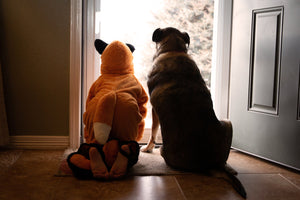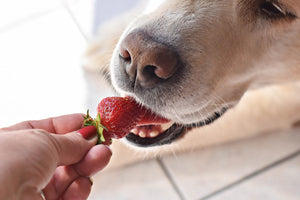Understanding “Autism-Like” Behaviors in Dogs
When dogs exhibit unusual behaviors—like avoiding eye contact, reacting poorly to change or repeating the same actions over and over—it’s natural for pet owners to wonder: Can dogs have autism? While it might seem like some dogs are showing signs of a neurodivergent condition, the truth is a little more complex. Veterinarians don’t diagnose autism in dogs, but some animals may have what’s referred to as Canine Dysfunctional Behavior (CDB).

Can Dogs Have Autism?
While the behaviors might look familiar to what we associate with autism in humans, dogs cannot technically be diagnosed with autism. The term doesn’t appear in veterinary manuals like the DSM or ICD, and there’s no standardized testing to determine whether a dog is autistic.
Instead, researchers and veterinarians use terms like Canine Dysfunctional Behavior to describe dogs that exhibit certain atypical patterns, particularly when those patterns are not explained by training issues, trauma or illness. It’s not that dogs can’t have neurological differences, it’s just that we don’t yet fully understand what that would look like in scientific terms.
Autism in Humans vs Dogs
In humans, autism is defined by a specific set of diagnostic criteria, including social communication challenges, restricted or repetitive behavior and sensory sensitivities. It’s typically diagnosed through detailed behavioral assessments and developmental history.
Dogs can’t verbalize how they feel, and their behavior is often interpreted through a human lens. That means what looks like autism in a dog may actually be something different.
What Might Cause “Autism-Like” Behaviors in Dogs?
Beyond genetics, there are several environmental and physical factors that could lead to behaviors mistaken for autism:
- Chronic stress or anxiety can alter a dog’s behavior and lead to withdrawal or compulsions
- Pain or illness such as undiagnosed seizures or neurological disorders can cause odd behavior patterns
- Lack of enrichment or mental stimulation may cause a dog to fixate on repetitive actions
- Isolation or poor socialization early in life can make dogs fearful, aloof or hesitant around others
Before assuming a neurological condition, it’s important to rule out physical health problems by visiting a veterinarian.

Can Dogs Have ADHD?
Some dogs may seem hyperactive, distracted or unable to focus, which can raise questions about canine ADHD. Unlike in humans, there is no official diagnosis for ADHD in dogs. What we often see as hyperactivity might be high energy levels, lack of stimulation or breed tendencies (like in working or herding dogs).
In both cases—ADHD and autism—the overlap between human and canine behavior can be misleading. Dogs don’t have the same emotional or cognitive expression as humans, so while behaviors may look similar on the surface, the root causes and proper interpretations are very different.
Signs of Canine Dysfunctional Behavior
Canine Dysfunctional Behavior is the term used to describe consistent, abnormal patterns of behavior in dogs that aren’t caused by poor training or environmental stressors alone. Some potential signs include:
- Repetitive behaviors like spinning, tail chasing or paw licking
- Avoidance of touch or eye contact
- Resistance to changes in routine or surroundings
- Overreaction to noise, movement or new environments
- Difficulty socializing with humans or other dogs
These behaviors can be mistaken for stubbornness, fear or even bad training but they may signal something deeper neurologically.
Causes of Canine Dysfunctional Behavior
So, what causes CDB? Like many behavioral issues in animals, it’s often a mix of nature and nurture. Some possible causes include:
- Genetic predisposition – Some breeds may be more prone to specific traits like compulsiveness or emotional detachment
- Early-life trauma or neglect – Puppies who miss key socialization periods may struggle later
- Neurological development issues – Just like in humans, things can go awry during a dog’s brain development
- Inbreeding or poor breeding practices – Certain traits can be unintentionally passed down when dogs are bred without proper genetic screening

How to Manage Canine Dysfunctional Behavior
If your dog exhibits signs of CDB or any other concerning behavior, don’t panic. There are plenty of ways to help support your pup:
- Consult a veterinary behaviorist for a thorough evaluation and treatment plan
- Create a consistent daily routine to help reduce anxiety
- Use positive reinforcement training techniques to encourage healthy behaviors
- Enrich your dog’s environment with puzzle toys, social time and safe outdoor experiences
- Be patient and understanding, keeping in mind that all dogs are different and progress takes time
With the right combination of support and professional guidance, many dogs with CDB or similar behaviors can thrive.
Every Dog Deserves Compassion
While dogs can’t be diagnosed with autism in the same way humans can, they can exhibit behaviors that seem eerily similar. These behaviors are often grouped under the label of Canine Dysfunctional Behavior, a still-emerging field in veterinary science. Whether caused by genetics, early development or the environment, these behaviors deserve compassion, curiosity and care. If you think your dog might be showing signs of CDB, talk to your vet and explore behavior therapy options to help your pup live a full and happy life.

















